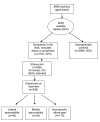Occupation and epicondylitis: a population-based study
- PMID: 22019808
- PMCID: PMC3427015
- DOI: 10.1093/rheumatology/ker228
Occupation and epicondylitis: a population-based study
Abstract
Objective: To explore the relationship between occupational exposures and lateral and medial epicondylitis, and the effect of epicondylitis on sickness absence in a population sample of working-aged adults.
Methods: This was a cross-sectional study of 9696 randomly selected adults aged 25-64 years involving a screening questionnaire and standardized physical examination. Age- and sex-specific prevalence rates of epicondylitis were estimated and associations with occupational risk factors explored.
Results: Among 6038 respondents, 636 (11%) reported elbow pain in the last week. Of those surveyed, 0.7% were diagnosed with lateral epicondylitis and 0.6% with medial epicondylitis. Lateral epicondylitis was associated with manual work [odds ratio (OR) 4.0, 95% CI 1.9, 8.4]. In multivariate analyses, repetitive bending/straightening elbow >1 h day was independently associated with lateral (OR 2.5, 95% CI 1.2, 5.5) and medial epicondylitis (OR 5.1, 95% CI 1.8, 14.3). Five per cent of adults with epicondylitis took sickness absence because of their elbow symptoms in the past 12 months (median 29 days).
Conclusion: Repetitive exposure to bending/straightening the elbow was a significant risk factor for medial and lateral epicondylitis. Epicondylitis is associated with prolonged sickness absence in 5% of affected working-aged adults.
Figures
References
-
- Morris H. Riders sprain. Lancet. 1882;ii:557.
-
- Walker-Bone K, Palmer KT, Reading I, Cooper C. Soft-tissue rheumatic disorders of the neck and upper limb: prevalence and risk factors. Seminars Arth Rheum. 2003;33:185–203. - PubMed
-
- Kurppa K, Viikari-Juntura E, Kuosma E, Huuskonen M, Kivi P. Incidence of tenosynovitis or peritendinitis and epicondylitis in a meat-processing factory. Scand J Work Environ Health. 1991;17:32–37. - PubMed
-
- Viikari-Juntura E, Kurppa K, Kuosma E, Huuskonen M, Kuorinka I, Ketola U. Prevalence of epicondylitis and elbow pain in the meat-processin industry. Scand J Work Environ Health. 1991;17:38–45. - PubMed
-
- Roto P, Kivi P. Prevalence of epicondylitis and tenosynovitis among meatcutters. Scand J Work Environ Health. 1984;10:203–5. - PubMed
Publication types
MeSH terms
Grants and funding
LinkOut - more resources
Full Text Sources
Medical
Miscellaneous


